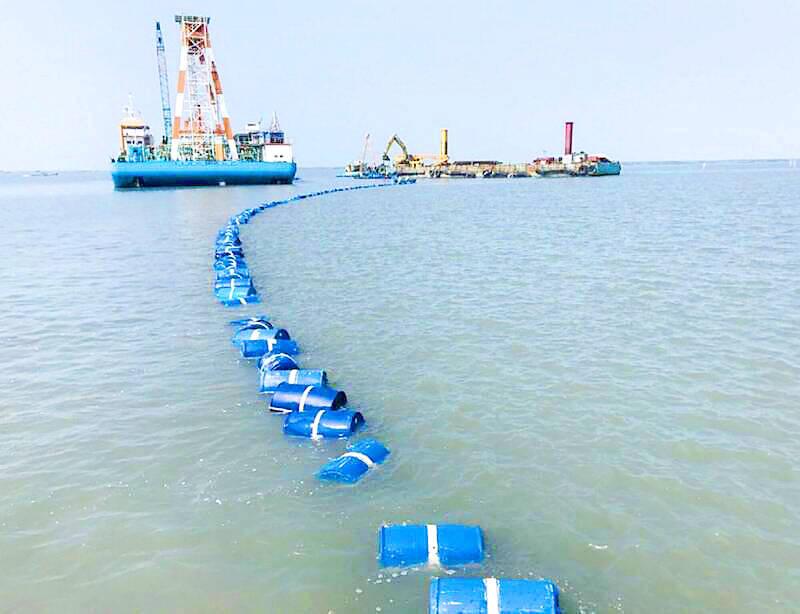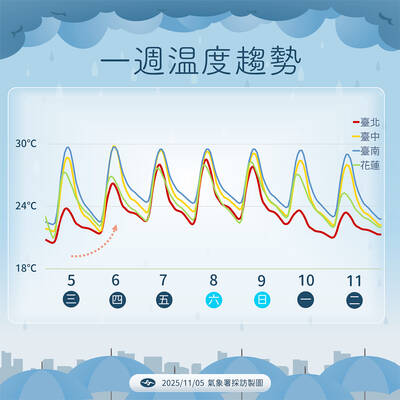A power issue that occurred on Saturday on the Asia-Pacific Gateway (APG) undersea cable has caused some connection delays on certain foreign Web sites, but has not affected Internet use in general, the Ministry of Digital Affairs said yesterday.
The ministry said that the disruption occurred on Saturday on the S3 section of the APG cable, about 66km off Shanghai in eastern China.

Photo courtesy of Taiwan Power Co
The fault was linked to an abnormal power supply and did not involve the cable's Taiwan landing point, the ministry said.
However, some users of Chunghwa Telecom's HiNet service may experience slight delays when connecting to Web sites in China, Hong Kong, Japan and Singapore during peak hours, the ministry said.
Major online services such as Google, YouTube, Facebook, Netflix, Telegram and AWS, which rely on local caches or direct connections in Taiwan, remain unaffected, it added.
The affected cable has already been rerouted to improve communication and Internet access, it said, adding that Chunghwa Telecom was working with the APG cable consortium to fix the problem.
Yesterday, Chunghwa Telecom said in a separate statement that emergency rerouting had been completed, and general connections to Hong Kong, Japan and Singapore had stabilized outside of peak hours.
Repair work is still being carried out, Chunghwa Telecom said, adding that it could not yet give a completion date.

UNILATERAL MOVES: Officials have raised concerns that Beijing could try to exert economic control over Kinmen in a key development plan next year The Civil Aviation Administration (CAA) yesterday said that China has so far failed to provide any information about a new airport expected to open next year that is less than 10km from a Taiwanese airport, raising flight safety concerns. Xiamen Xiangan International Airport is only about 3km at its closest point from the islands in Kinmen County — the scene of on-off fighting during the Cold War — and construction work can be seen and heard clearly from the Taiwan side. In a written statement sent to Reuters, the CAA said that airports close to each other need detailed advanced

Tropical Storm Fung-Wong would likely strengthen into a typhoon later today as it continues moving westward across the Pacific before heading in Taiwan’s direction next week, the Central Weather Administration (CWA) said. As of 8am, Fung-Wong was about 2,190km east-southeast of Cape Oluanpi (鵝鑾鼻), Taiwan’s southernmost point, moving westward at 25kph and possibly accelerating to 31kph, CWA data showed. The tropical storm is currently over waters east of the Philippines and still far from Taiwan, CWA forecaster Tseng Chao-cheng (曾昭誠) said, adding that it could likely strengthen into a typhoon later in the day. It is forecast to reach the South China Sea

WEATHER Typhoon forming: CWA A tropical depression is expected to form into a typhoon as early as today, the Central Weather Administration (CWA) said yesterday, adding that the storm’s path remains uncertain. Before the weekend, it would move toward the Philippines, the agency said. Some time around Monday next week, it might reach a turning point, either veering north toward waters east of Taiwan or continuing westward across the Philippines, the CWA said. Meanwhile, the eye of Typhoon Kalmaegi was 1,310km south-southeast of Oluanpi (鵝鑾鼻), Taiwan’s southernmost point, as of 2am yesterday, it said. The storm is forecast to move through central

UNKNOWN TRAJECTORY: The storm could move in four possible directions, with the fourth option considered the most threatening to Taiwan, meteorologist Lin De-en said A soon-to-be-formed tropical storm east of the Philippines could begin affecting Taiwan on Wednesday next week, the Central Weather Administration (CWA) said yesterday. The storm, to be named Fung-wong (鳳凰), is forecast to approach Taiwan on Tuesday next week and could begin affecting the weather in Taiwan on Wednesday, CWA forecaster Huang En-hung (黃恩鴻) said, adding that its impact might be amplified by the combined effect with the northeast monsoon. As of 2pm yesterday, the system’s center was 2,800km southeast of Oluanbi (鵝鑾鼻). It was moving northwest at 18kph. Meteorologist Lin De-en (林得恩) on Facebook yesterday wrote that the would-be storm is surrounded by